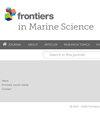入侵互花米草生物量分配的纬向趋势:对盐沼适应气候变暖的启示
IF 3
2区 生物学
Q1 MARINE & FRESHWATER BIOLOGY
引用次数: 0
摘要
盐沼地上池和地下池的生物量分配对盐沼稳定性有明显影响,并受气候变暖和生殖投资的影响。然而,由于缺乏对盐沼植物生殖投资和生物量分配的纬度变化影响的研究,难以跨地理尺度探索盐沼植物生长对气候变暖的影响机制。盐沼草互花米草在世界各地低纬度沼泽的快速入侵为研究跨纬度的生物量分配和生殖投资提供了机会,有助于了解盐沼如何应对气候变暖。方法在东营(高纬37.82°N)至儋州(低纬19.73°N) 2000 km范围内,选取10个地理位置19个样点,对互花草地上生物量(AGB)、地下生物量(BGB)、总生物量、有性生殖性状(花序生物量、花茎生物量)、无性生殖性状(芽数、根茎生物量)进行了研究。结果AGB、BGB和总生物量与纬度呈驼峰关系,但BGB / AGB比值随纬度的增加而减小(即随温度的升高而线性增加)。有趣的是,我们发现BGB: AGB比值与有性生殖投资呈负相关,而与无性生殖投资呈正相关。虽然盐沼稳定性和碳积累的概念和数值模型通常基于地上生物量来推断响应,但我们的研究表明,基于地上生物量和静态分配的盐沼对气候变暖的响应可能会影响气候变暖驱动下的未来盐沼产量的估计。本文章由计算机程序翻译,如有差异,请以英文原文为准。
Latitudinal trends in the biomass allocation of invasive Spartina alterniflora: implications for salt marsh adaptation to climate warming
IntroductionBiomass allocation between aboveground and belowground pools in salt marshes has distinct effects on salt marsh stability, and is influenced by climate warming and reproductive investment. However, the lack of studies on the effect of latitudinal variations in reproductive investments and biomass allocation in salt marshes makes it difficult to explore mechanisms of marsh plant growth to climate warming across geographical scales. The rapid invasion of the salt marsh grass Spartina alterniflora into lower latitude marshes around the world provides an opportunity to investigate biomass allocation and reproductive investment across latitudes, helping to understand how salt marshes respond to climate warming.MethodsTherefore, we investigated aboveground biomass (AGB), belowground biomass (BGB), total biomass, sexual reproduction traits (inflorescence biomass, flowering culm), asexual reproduction traits (shoot number, rhizome biomass), among S. alterniflora at 19 sites in 10 geographic locations over a latitudinal gradient of ~2000 km from Dongying (37.82°N, high latitude) to Danzhou (19.73°N, low latitude) in China.ResultsThe AGB, BGB, and total biomass displayed hump shaped relationships with latitude, but the BGB: AGB ratio decreased with increasing latitude (i.e. increased linearly with temperature). Interestingly, we found that the BGB: AGB ratio negatively correlated with sexual reproductive investment, but positively correlated with asexual reproductive investment.DiscussionWhile conceptual and numerical models of salt marsh stability and carbon accumulation often infer responses based on aboveground biomass, our study suggests that salt marsh responses to climate warming based on aboveground biomass and static allocations may bias estimates of future salt marsh production driven by climate warming.
求助全文
通过发布文献求助,成功后即可免费获取论文全文。
去求助
来源期刊

Frontiers in Marine Science
Agricultural and Biological Sciences-Aquatic Science
CiteScore
5.10
自引率
16.20%
发文量
2443
审稿时长
14 weeks
期刊介绍:
Frontiers in Marine Science publishes rigorously peer-reviewed research that advances our understanding of all aspects of the environment, biology, ecosystem functioning and human interactions with the oceans. Field Chief Editor Carlos M. Duarte at King Abdullah University of Science and Technology Thuwal is supported by an outstanding Editorial Board of international researchers. This multidisciplinary open-access journal is at the forefront of disseminating and communicating scientific knowledge and impactful discoveries to researchers, academics, policy makers and the public worldwide.
With the human population predicted to reach 9 billion people by 2050, it is clear that traditional land resources will not suffice to meet the demand for food or energy, required to support high-quality livelihoods. As a result, the oceans are emerging as a source of untapped assets, with new innovative industries, such as aquaculture, marine biotechnology, marine energy and deep-sea mining growing rapidly under a new era characterized by rapid growth of a blue, ocean-based economy. The sustainability of the blue economy is closely dependent on our knowledge about how to mitigate the impacts of the multiple pressures on the ocean ecosystem associated with the increased scale and diversification of industry operations in the ocean and global human pressures on the environment. Therefore, Frontiers in Marine Science particularly welcomes the communication of research outcomes addressing ocean-based solutions for the emerging challenges, including improved forecasting and observational capacities, understanding biodiversity and ecosystem problems, locally and globally, effective management strategies to maintain ocean health, and an improved capacity to sustainably derive resources from the oceans.
 求助内容:
求助内容: 应助结果提醒方式:
应助结果提醒方式:


